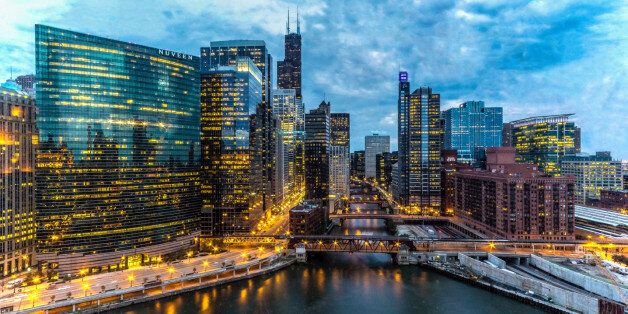
The Chicago Spire was supposed to be the tallest building in the United States. Instead of soaring 2,000 feet into the sky, today the foundation plunges 76 feet below ground, sitting abandoned and undeveloped right across from Navy Pier and along iconic Lake Shore Drive. What was to serve as the base for an opulent architectural landmark is just a deep, dark hole taking up prime real estate and reminding the city of what could have been.
The pit is a physical reminder of the unrealized promise of the Spire, but its imagery also reflects the depth of its city's financial despair.Behind a veneer of affluence, gilded by the prosperity and staying power of neighborhoods such as the Gold Coast, River North and Lincoln Park, the city's foundation is crumbling beneath the weight of perilous debt. Chicago and its sister governments are officially on the hook for more than $32 billion in unfunded pension debt. With just over a million households in the city, that staggering figure means each Chicago household is on the hook for $32,000 to cover these liabilities. Chicago's pension debt exceeds the state's total proposed operating budget for the upcoming fiscal year.
At the same time the city's obligations are skyrocketing, its population is growing at a snail's pace, gaining just 6,000 residents in 2013 after a decade of population decline. With 2.7 million residents as of 2013, Chicago's population is the same as it was in 1920.But the city used to be a beacon of hope and prosperity.
In 1884, more than 120 years before the Spire project was unveiled, Chicago became the birthplace of the skyscraper upon the completion of the 10-story Home Insurance Building.
In 1916 author Carl Sandburg gave birth to the nickname, "the city of big shoulders," a nod to Chicago's grit and work ethic. By 1890, its population topped 1 million, and it was the fastest growing city in the world. The year before, it had officially become the second-biggest city in the country, according to records from the University of Illinois at Chicago.
Business was booming then, driven mostly by the growth of railroads. Continued rail growth led to the birth of the Union Stockyards, a centralized slaughterhouse built to accommodate Chicago's growth in the livestock industry. Around 1900, Chicago's meatpacking industry employed more than 25,000 people and produced 82 percent of the meat consumed in the United States, according to the Chicago History Museum. The late 1800s and early 1900s were also the era of the iconic State Street Marshall Field & Co., originally a dry goods store that eventually became one of the biggest department stores in the country.
Chicago was a center of commerce and culture, a booming hub where East met West.
But today, despite activity on the tech front, job opportunities are scarce. The Chicago area has 46,000 fewer people working compared to before the Great Recession, according to the Bureau of Labor Statistics.
In 1851, writers at the Chicago Tribune wrote in the "Annual Review of Commerce" something that still holds true today:
"Essential to the prosperity of cities ... It matters but little how great the natural advantages with respect to a location upon navigable water, if [cities] fail to avail themselves of this new element of power, a decline is inevitable."
Back then the "essential power" was the railroad, and the Tribune writers recognized that this industry would serve as the driver behind future prosperity. Today, economic drivers that would make the city great once more are set back on multiple fronts: the city buries would-be entrepreneurs in paperwork for the fees and permits required to set up shop; it can take weeks or months just to get approval from City Council to start a business; and anyone thinking of opening a business here has to consider the prospect of having to shoulder the city's heavy debt burden if City Hall can't embrace reform.
The Spire and those who held its financial obligations filed for bankruptcy in 2013. They owed $77.3 million on the project, according to the Chicago Tribune. Without swift action, the city could suffer a similar fate.
Unlike the Spire, Chicago doesn't have to keep sinking. If city officials change the way Chicago handles spending and debt, as well as how it fosters business and jobs growth, the city of big shoulders can boom once more.
